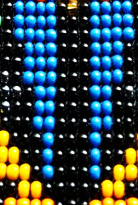Challenges 1
Algorithmic Challenges

The Mayan symbol for the universe (“cosmogram”). The central diamond shape is the sun.

This twelve-cornered cross appears in some Incan designs prior to European contact, though no one knows its symbolic meaning. If the white figure at the center is supposed to be a circle, it should become more rounded as you create larger versions. See if you can you calculate the placement of the beads for a larger version of this design.

These blue beads create a very steep angle. They are the tails of two Macaws in beadwork from the the Embera Chamí people of Colombia. What is the slope? How does this compare to the slope of the Mayan cosmogram? Why might the Mayan angle be more common (from a mathematical point of view)?


This design is also from the Embera Chamí people in Columbia. The blue figure at center is called the star of creation. How could you make that from triangles? From other shapes? How can iteration help simulate such gradients of color or shade?
Statistics Challenges
The Metropolitan Museum of Art in New York city has hired you to determine whether its new acquisitions of Latin American beadwork is authentic. Your job is to create a simulation of a known authentic original, and then compare the variance of color in the simulation to the new acquisitions.
- The first column of your simulation is complete. Its color range is narrow (0 to 20). You will need to add two or three more columns, and a wider range of colors, to make it a better match to the museum’s sample. Don't forget to save your work, and write down the color range you used.
- Now that you know the color range, you can calculate the variance. When you have a set of consecutive integers, the mean is (smallest + largest)/2. You can estimate the variance for the new color range you created using the formula for the estimate of the mean of your random numbers, along with the following project:
-
This program already calculates the sum of the squares. Add the missing block to help it calculate the variance.
-
Use the following steps to calculate the variance from a set of values:
- Calculate the mean of the sample (using (smallest + largest)/2).
- Subtract the mean from each data point. ↓
- Square each result. ↓
- Find the sum of the squared values. ↓
- Divide by n - 1, where n is the number of data points.